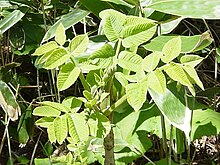Toxicodendron vernicifluum
| Toxicodendron vernicifluum | |
|---|---|
 |
|
| Scientific classification | |
| Kingdom: | Plantae |
| (unranked): | Angiosperms |
| (unranked): | Eudicots |
| (unranked): | Rosids |
| Order: | Sapindales |
| Family: | Anacardiaceae |
| Genus: | Toxicodendron |
| Species: | T. vernicifluum |
| Binomial name | |
|
Toxicodendron vernicifluum (Stokes) F. Barkley |
|
Toxicodendron vernicifluum (formerly Rhus verniciflua), also known by the common name Chinese lacquer tree, is an Asian tree species of genus Toxicodendron (formerly Rhus) native to China and the Indian subcontinent, and cultivated in regions of China, Korea and Japan. Other common names include Japanese lacquer tree,Japanese sumac, and varnish tree. The trees are cultivated and tapped for their toxic sap, which is used as a highly durable lacquer to make Chinese, Japanese, and Korean lacquerware.
The trees grow up to 20 m tall with large leaves, each containing from 7 to 19 leaflets (most often 11-13). The sap contains the allergenic compound urushiol, which gets its name from this species' Japanese name urushi (urushi (漆?)); "urushi" is also used in English as a collective term for all kinds of Asian lacquerware made from the sap of this and related Asian tree species, as opposed to European "lacquer" or Japanning made from other materials. Urushiol is the oil found in poison ivy that causes a rash.
A caustic, toxic sap, containing urushiol, is tapped from the trunk of the Chinese lacquer tree to produce lacquer. This is done by cutting 5 to 10 horizontal lines on the trunk of a 10-year-old tree, and then collecting the greyish yellow sap that exudes. The sap is then filtered, heat-treated, or coloured before applying onto a base material that is to be lacquered. Curing the applied sap requires "drying" it in a warm, humid chamber or closet for 12 to 24 hours where the urushiol polymerizes to form a clear, hard, and waterproof surface. In its liquid state, urushiol can cause extreme rashes, even from vapours. Once hardened, reactions are possible but less common.
...
Wikipedia
